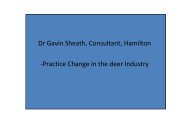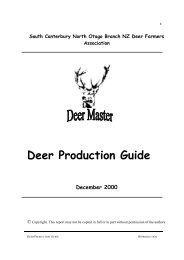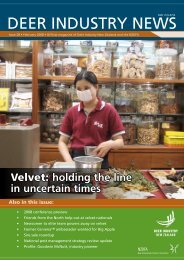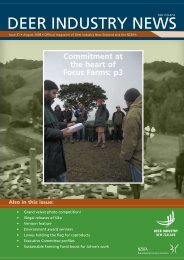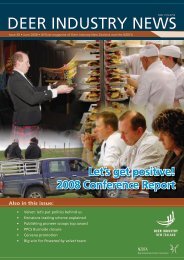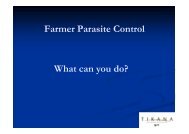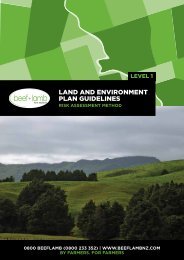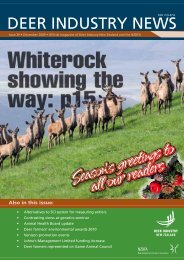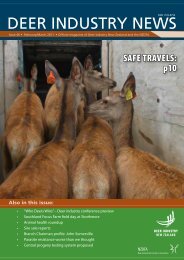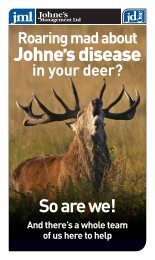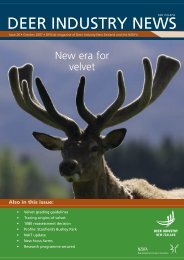Deer Industry News #36 June 2009 - Deer Industry New Zealand
Deer Industry News #36 June 2009 - Deer Industry New Zealand
Deer Industry News #36 June 2009 - Deer Industry New Zealand
- No tags were found...
Create successful ePaper yourself
Turn your PDF publications into a flip-book with our unique Google optimized e-Paper software.
general news100 kilogram weaners before winterWhen dairy genetics co-operative LIC decided to apply its skills to improving venison productivity, there were a fewraised eyebrows. Five years later in <strong>2009</strong> the vision of the “100 kg weaner before winter” is a reality.<strong>Deer</strong> Improvement’s Balfour Research Farm Manager, DesFord, weighs the animals every six weeks in a carefullystructured programme that involves extensive DNA testingand meticulous mob management to ensure accuracy ingenetic evaluation. On 29 May he confirmed that the latestcrop of stag fawns born around 15 November had indeedtopped the magic mark, averaging 100.8 kg.The farm is managed along commercial lines, with theweaners fed solely on grass until going on to a crop in <strong>June</strong>while the hinds are wintered on self-feed silage.The concept of finishing animals at six months of age hasobvious appeal to farmers wishing to reduce stock unitsthrough the feed pinch, although pre-winter scheduleprices have generally not been strong. <strong>Deer</strong> Improvementis undeterred, pointing out that building demand outsidethe traditional peak season is a key objective of venisonmarketers. They highlight the availability of year-roundsupply contracts being offered by Firstlight Venison, which iswell established in the North Island and currently expandingits operation into the South Island.Des Ford says the concept of the faster-growing weanerdoes not depend on pre-winter sales anyway. He cites theability to achieve weights near the top end of the rangewhich attracts premium prices in spring (up to 65kg carcassweight). “You can’t get those weights in September if youhaven’t made a lot of progress pre-winter.” This is becausedeer growth rates decline markedly during winter regardlessof feeding strategies. “Well-grown weaners provide flexibility.They give you options.”An added benefit he has observed is the opportunity toget yearling hinds away at spring premiums, ensuring allslaughter animals are gone before the next crop of fawns hitsthe ground.“Even at a 20 percent replacement rate, mostof your hinds are being bred for slaughter. Thecombined impact of selling more animals atheavier weights at the schedule peak is likeshifting the whole farm into another gear. Andbecause animals are spending less time on farm,maintenance feed is slashed. Retaining animalsinto the summer dry period is very expensivewhen you consider that two-thirds of feed intakeis solely for maintenance. Getting them awayearlier means better feed utilisation – morekilograms of venison per tonne of dry matter.”<strong>Deer</strong> <strong>Industry</strong> <strong>New</strong> <strong>Zealand</strong> Producer Manager,Tony Pearse, says the concept of more deer atgreater weights, sooner, is perfectly aligned withthe industry productivity strategy, in turn linkedto an objective in the just-reviewed venisonstrategy.“We’re no different to any other livestockenterprise. We’ve got to continuously improveproductivity which means more output per unit<strong>Deer</strong> Improvement Research Farm Manager, Des Ford, saysweaners that are well-grown before winter give flexibility whenit comes to timing of slaughter.of input. The crossbred terminal sire has provided an efficientproven track to improved growth rate for many years, butit’s clearly not for everybody. What’s being achieved nowin Red deer is remarkable and provides enormous flexibilityunder many different deer farming conditions, where peoplecan now set a hind size that suits their systems and feedingcapabilities.”Tony visited the Balfour property during the mid-Aprilweighing to see RFID in action and was impressed with theoperation and the genetics. “The animals handled beautifully,they looked magnificent, and the integrated system ofelectronic tags and scales really gave me a look into thefuture.”■■Article and photos contributed to <strong>Deer</strong> <strong>Industry</strong> <strong><strong>New</strong>s</strong> by<strong>Deer</strong> Improvement.Yearling donor hinds in late April at the Balfour farm. <strong>Deer</strong> Improvement says theseanimals represent the future of Red deer genetics for venison production.26<strong>Deer</strong> <strong>Industry</strong> <strong><strong>New</strong>s</strong>



